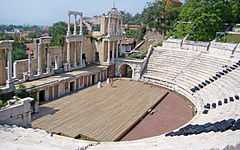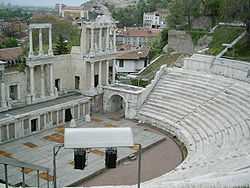Plovdiv Roman theatre
Coordinates: 42°08′49″N 24°45′04″E / 42.14684°N 24.751006°E

The ancient theatre of Philippopolis is a historical building in the city center of Plovdiv (ancient Philippopolis), Bulgaria. Although this structure is commonly referred to as an amphitheatre, it is actually a traditional Greek theatre. It stands between the south-western slope of the Dzhambaz Tepe and the Taxim tepe hill within the old town, and is a major tourist attraction for travelers coming to the area. According to a builders’ inscription, discovered on the frieze-architrave of the eastern proskenion, the construction of the theatre dates back to the time of Emperor Trajan (reigned 98–117 AD).
Description
The spectator seats are orientated to the south, towards the ancient city in the lowland and the Rhodope Mountains. In outline, the theatre is a semi-circle with an outer diameter of 82 meters.
The open spectators' area (cavea) includes 28 concentric rows of marble seats, divided into two tiers by an aisle (diazoma). The upper part of the tiers is interrupted by narrow radial stairways, which divide the cavea into wedge-shaped sectors (kerkides). The spectator seats surround the stage – the orchestra – which has the shape of a horseshoe and is 26.64 meters in diameter.
The stage building – the skene – is south of the orchestra. It has three floors. The stage area (proskenion) is 3.16 meters high and its facade, which is facing the orchestra, is decorated with an Ionic marble colonnade with triangular pediments. The facade of the skene which overlooks the spectators' area consists of two two-storey porticos, the first in the Greek Ionic order and the second in the Greek-Corinthian order. The facade is cut through by three symmetrically located gates.
The entrances to the orchestra (parodoi) which were initially uncovered and, afterwards, vaulted connect the cavea with the stage building. An underground vaulted passage begins from the centre of the orchestra, goes under the stage building and leads out of the theatre. Another vaulted passage, passing under the central bank of seats of the top tier, connects the cavea with the Three Hills area. Over the passage the box of the dignitaries was situated.
Similar to all the theatres on the territory of the Roman Empire, in the theatre of Philippopolis the honorary spectator seats were inscribed. There were inscriptions not only for the representatives of the city council but also for magistrates, friends of the Emperor, etc. Some honorary inscriptions show that the building was used as the seat of the Thracian provincial assembly.
Presumably, gladiatorial fights with animals were held in the theatre, as remains of safety facilities in front of the first row have been uncovered. These additions were set because of the visit of Emperor Caracalla to Philippopolis in 214 AD.
The restoration of the Roman theatre in Plovdiv is considered one of the best achievements of the Bulgarian Conservation School. The intervention is limited on the basis of rigorous tests and exclusion of assumptions. The reconstruction was made strictly according to the method of аnastylosis and the new material is clearly visible. Today the theater of the Three Hills is one of the emblems of the city and a stage for classical drama, dance and music.
The theatre is one of the numerous constructions from the time of the Roman Empire, preserved in Bulgaria. There are several steles and wall inscriptions in Greek language in the theatre.
Built with around 7,000 seats, each section of seating had the names of the city quarters engraved on the benches so the citizens knew where they were to sit.
The theater was damaged in the 5th century AD by Attila the Hun.
The theater was only found in the early 1970s due to a landslide. This caused a major archeological excavation, including the removal of some 4.5 m of earth covering what was left hidden by the landslide.
Culture
During the summer months, the theatre hosts theatrical plays and musical shows.
The prize award ceremony of the 21st International Olympiad in Informatics was held in the theatre.[1]
Inscriptions from the theatre
References
- ↑ ioi2009.org
- Regional Archaeological Museum Plovdiv - Roman Art, Ancient Sculptures Collection
- The Ancient Stadium of Philippopolis - The Ancient Philippopolis and the Ancient Theatre
| ||||||||||||||||||||||||||||||||




